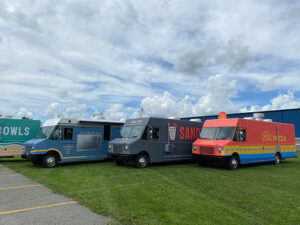Working on developing repeat food truck business

Brick and mortar food trucks can rely on returning customers, so you need a solid food marketing plan to attract and engage customers. A well-planned food truck marketing strategy coupled with an adequate food truck business plan brings you and your target audience together. These strategies will help you get off to a good start when marketing your food truck:
Who should you target with your Food truck marketing strategy?
Food truck businesses need to understand their target audiences before they can create a successful marketing strategy. A billion-dollar industry is attracting middle-class millennials to food trucks. According to IBISWorld Inc. research, 43% of food truck spending is made by people aged 25- to 44, and 20% is made by people younger than 25.
Understanding people’s habits
People who work in commercial areas where there are few options for meals appreciate the convenience of food trucks. Small businesses are more likely to be supported by millennials and Generation Z-ers than chains.
Those who frequent food trucks enjoy sampling new cuisines and flavor combinations without committing to a sit-down meal. Food trucks are a popular trend among millennials, and they share photos of their unique food truck meals on social media. People enjoy dining in parks and creating communal dining spaces at events with other food truck patrons.
Developing your Food Truck Marketing Plan
Public recognition and identification of your business are made easier with a strong marketing presence. Make sure you’re using a variety of marketing approaches and channels to support your marketing efforts, whether through an eye-catching graphic, a catchy jingle, or a memorable tagline. For your message to reach and engage your customers, a strategic marketing approach is crucial. We’ve outlined the essentials of food truck marketing below:
Your Branding
The food truck industry is becoming increasingly saturated, so your branding sets you apart from everyone else. Develop a distinctive brand to help you maintain your business. Read on for key elements of a strong food truck branding strategy.
Logos should be simple and easy to understand.
Font: Using a bit of creativity can help you support the overall mood of your business, but make sure that important information is legible.
Food truck operators usually decorate their trucks with eye-catching graphics to make their products more appealing to customers. As you drive around town, you can advertise your business by decorating the outside of your truck.
Copy (aka words): The names of menu items are part of your brand, as are the items on your menu. When you make social media posts or write about your business for print and online publications, you also need to use the copy.
Some basic thoughts on Website Development
While all dining establishments need a website, your food truck’s website has unique needs. As the food truck market is primarily comprised of people aged 44 and younger, the primary way your customers will discover your business is online. Make sure your website includes the following:
Display Your Location Schedule: Since your business does not have a fixed location, it is imperative that potential customers can discover where you are located each day on your website.
Those who are intrigued by your website’s images and a copy will want to find out what’s all the fuss about in your menu.
Once people have decided they want to eat at your food truck, they will need to know what hours you are open. Including typical places you operate can help people see whether you can become a lunch spot staple or if it will require a weekend trip to get a taste of what you offer.
You can boost your marketing efforts by including your mission statement on your website, because of the typical reasons people dine at a food truck is to support local entrepreneurs and connect with their communities.
You must have mouth-watering photos of your food on your website to convince people to buy from you.
The Role of Social Media Marketing
Social media isn’t just a way for food trucks to communicate with their customers. The tool is crucial to a successful food truck business.
Best practices for food truck social media marketing
You will receive reviews and questions about your food truck on your social media pages. Review management is just as important as the reviews themselves, if not more so.
- Communication: Create a poll to ask customers where you should be located and run new menu items by them. As well as helping you understand exactly how to run your business, these posts help generate a steady stream of content.
Your food truck’s social media marketing strategy should include a steady stream of food photography images showing off your menu items. Create creative, actionable captions aligned to your food truck’s branding to showcase your daily/weekly specials, new menu items, and best-selling dishes.
- Giveaway: Be able to offer free items in exchange for people following your account, tagging their friends in the giveaway post comments, and sharing the giveaway on their own social media pages so that they engage with your account. Whether you partner with local cultural magazines, food bloggers, city activity pages, or food blogs, you can gain more exposure for your giveaway challenge and provide more services to the giveaway winner.
You can get attractive images without having to generate all the content yourself by posting the photos your customers tag your business in and sharing them. Before publishing their photo, obtain their permission, and make sure to include their name and/or photo in the caption to give them credit!
Platforms that are best for food trucks on social media
Share information about your business on your Facebook page and engage with your customers. In addition to following general social media best practices for food truck marketing, here are some specific ways to make the most of your Facebook page:
Make an event: If you know you’ll be parked at a local brewery for pint night or will be feeding hungry concert attendees, create an event on Facebook for people to add to their events calendar.
Answer Questions: Users may ask questions about your food truck on your Facebook page. Follow up with customers who contact you through your food truck’s Facebook page and Facebook Messenger inbox.
- Yelp
Even if you don’t have a Yelp account, your business will get rated and reviewed. Maintain an active Yelp page for your food truck and control the narrative. You can market your food truck for free by getting more Yelp reviews. Here are a few specialized ways to use your Yelp page to enhance your food truck’s social media marketing:
Request a “Find Us On Yelp” sticker to encourage customers to post reviews.
Provide Your Own Photos: Customer’s Yelp images tend to be of poor quality and don’t do your dishes justice. Making sure your food is well-represented on Yelp is as simple as including your own images.
You can market your food truck on Yelp by quickly assessing whether your food truck’s price is within your viewers’ budget range since food trucks are an affordable way to sample unique flavor combinations and cuisines.
As the food truck that started the modern food truck craze, Kogi showed how to use Twitter to build a brand and communicate with customers. Here are a few specialized ways to make the most of your food truck’s Twitter page besides following general social media food truck marketing best practices:
Let people know what you run out of as you move from one location to another as your supplies dwindle.
Share your brand on Twitter with funny, poignant statements. Show off your brand’s identity and values on your food truck’s Twitter account.
Images of your food look best on Instagram, the most aesthetic social media account. In addition to following general social media food truck marketing best practices, we have listed a few specialized ways to make the most of your Instagram page with your food truck. Our Instagram marketing guide is a great resource for more in-depth information.
Instagram Stories: Rather than having a curated Instagram feed, Instagram stories are a more candid way to share behind-the-scenes pictures and build customer relationships. To boost customer engagement rates for Instagram’s algorithm and glean feedback from customers, you can use Instagram story features like polls, quizzes, and questions.
Repost Images: Unlike Yelp, images of your food that customers upload to Instagram tend to be aesthetically pleasing. You will build your brand’s loyalty by resharing your customers’ photos, and there will be less need for you to attempt your own food photography.
Identify the influencers in your city and ask them to post videos, pictures, or Instagram stories showing them enjoying the food at your food truck. In exchange for their marketing, you may be able to give them free food, but if they have a large following, they may need compensation. As soon as possible, make sure you and the Influencer are clear about whether they will post an Instagram story, a photo, or a video about their experience.
Creating reels will let you edit and set music to short video clips. These are great for boosting your algorithm and engaging your followers, as well as allowing you to engage with them deeper. Additionally, reels are more likely to appear on Instagram’s “Explore Page”, letting more people find your profile and, consequently, your food truck.
- TikTok
TikTok’s entire platform relies on video, and video marketing is king in the social media marketing world. The Instagram Reels platform allows you to share those videos if you’re already making them on Instagram. Establish a Facebook page for your food truck, follow other food trucks and influencers in your area, and look for hashtags related to your business model or concept. Below are a few examples of food truck videos to make for TikTok as a strategy for marketing food trucks:
Make one of the recipes with your staff. From start to finish, film the construction of a meal. Show your followers your catering skills by showing them videos of the event you’re at Show the location where your truck is parked that day and where your surroundings are.
It’s also possible to get ideas and inspiration for videos from other accounts, but remember to stay original while being creative in a way that is authentic to you and your personality.
Food Presentation
Marketing your food truck successfully requires you to create visually appealing food presentations. Your food truck will gain exposure as food bloggers and everyday foodies alike post and share images of it. Aesthetic food presentation can also bring people more money.
How to Create Appealing Food Presentations?
- Easily photographable containers: Selecting disposable dinnerware, cups, and flatware should meet both your practical needs and help provide a specific and calculated impression on the diner. Patterns and bright colors are fun and can create engagement, but you risk upstaging your menu in images. Ordinary disposable containers let your food to take center stage.
- Interesting Containers: Simple containers do not distract from your food, but clever containers can go a long way towards marketing your food truck, such as serving gourmet ramen in a Cup of Noodles styrofoam cup.
- Garnishes that are unique: Adding extra garnishes to your dishes adds more flavor, color, texture, and height to your dishes, creating an eye-catching and delicious dish for your customers. Spices, edible flowers, and micro herbs are excellent options.
Which Are The Most Popular Foods From Food Trucks?
You need to understand your target consumer’s flavor preferences and serving style requirements before creating an attractive food presentation for your food truck menu. Food truck menus follow many of the same best practices as takeout and delivery menus. You should be aware of what has worked for others in your sector, as food trucks are a unique market.
The most popular food truck menu items are small items that can be held in your hands easily. Maybe the dishes are an innovative twist on childhood favorites like Mexican-Asian fusions, vegan reinventions, and organic or gourmet versions. You will need to inject your personality into popular items by incorporating your local ingredients, cultural heritage, or a fresh approach. Examples could include Lobster Rolls, Grilled Cheese, Popsicles, Falafel, Pizza, Burritos, Bao, Barbeque, Cupcakes, Sliders, Tacos, and Gyros
If you have a unique idea for reinventing the most popular food truck foods with new flavor profiles and presenting your food in an appealing way, you will have a marketable food truck.



